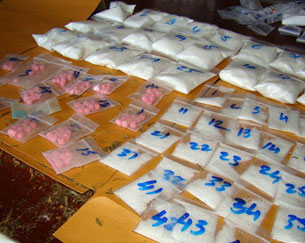 |
| Drug bust (Photo: Sok Serey, RFA) |
Wednesday, 28 March 2012
Buth Reaksmey Kongkea with additional reporting by Kristin Lynch
The Phnom Penh Post
The number of drug-related convictions in Cambodia nearly quadrupled last year,
a sobering statistic officials yesterday blamed on the nation’s
increasing popularity as a transit point for international drug
traffickers.
“Drug criminals continue to use Cambodia as a targeted place of drug
producing and drug trafficking,” Interior Minister Sar Kheng said in
Phnom Penh yesterday at the annual meeting of the National Authority for
Combating Drugs.
These activities were “dangerous” for Cambodian society, he said,
disrupting peace and security and impacting on people’s livelihoods, as
users were spending money on drugs instead of staples such as food and
shelter.
About 700 government officials from throughout the Kingdom attended
yesterday’s meeting, during which the NACD released its enforcement
statistics for 2011, which showed dramatic increases in several
categories of drug enforcement.
The number of drug-related convictions had shot to 951 last year from 248 in 2010, NACD chairman Ke Kim-yan said.
Drug-related arrests also jumped considerably to more than 1,300 in 2011, compared with 864 in 2010.
The number of drug raids conducted by authorities increased by 150 per cent.
Experts said yesterday these statistics were consistent with increased levels of trafficking in the country.
David Harding, an internat-ional adviser on drugs for the NGO Friends
International, said he had seen a stabilisat-ion of drug use across
Cambodia in the past two years, and these figures were “more a
reflection of an increase in traffic rather than an increase in use”.
Olivier Lemert, country manager for the UN Office on Drugs and Crime,
also pointed to the salience of Cambodia’s trafficking problem.
“The main point of all this is that Cambodia remains a key transit
country for ATS [amphetamine-type stimulants] and heroin and is being
increasingly targeted by international drug trafficking organisations,”
Lemert said by email yesterday.
A UNODC report released last November also observed increased levels
of trafficking, saying: “The manufacture, trafficking and use of illicit
drugs is a significant and worsening problem in Cambodia.
“There are indicators of increasing numbers of local and
international drug criminals using the country as a manufacturing base
and a transit route for ATS and other drugs.”
Lement said a “comprehensive response” was needed, “including, in
particular, access to voluntary-based . . . treatment, based in the
community”.
Sar Kheng called for greater co-operation with Laotian and Thai officials to help stem trafficking across those borders.
The UNODC report says there is “some likelihood” a recent Thai
anti-drug campaign could lead traffickers to smuggle more drugs into
Cambodia.
Despite the encouraging arrest and conviction statistics, Harding
said authorities were not catching “the big producers, the big
traffickers, the big distributors”.
“We’re not . . . seeing arrests made with a large amount of drugs,” he said.
These observations were supported by NACD statistics which revealed
that, despite the increased number of raids, the amount of drugs
confiscated had increased by a negligible amount, from 31 tonnes in 2010
to 34 tonnes this past year.

No comments:
Post a Comment